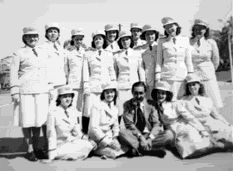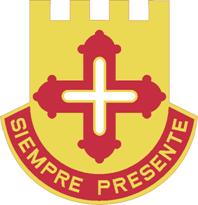
The recorded military history of Puerto Rico encompasses the period from the 16th century, when Spanish conquistadores battled native Taínos in the rebellion of 1511, to the present employment of Puerto Ricans in the United States Armed Forces in the military campaigns in Afghanistan and Iraq.

The Structure of the Argentine Army follows below. As of 2020 the active force of the Argentine Army includes a total of eleven brigades:

The Mexican Army is the combined land and air branch and is the largest part of the Mexican Armed Forces; it is also known as the National Defense Army.

The Puerto Rico National Guard (PRNG) –Spanish: Guardia Nacional de Puerto Rico– is the national guard of the U.S. Commonwealth of Puerto Rico. The Constitution of the United States specifically charges the National Guard with dual federal and state missions, which includes to provide soldiers and airmen to the United States Army and U.S. Air Force in national emergencies or when requested by the president of the United States, and to perform military operations at the state level or any other lawful service as requested by the governor of Puerto Rico. The PRNG responds to the governor of Puerto Rico, who serves as its commander in chief and imparts orders with the Puerto Rico adjutant general acting as conduit, and its local mission is to respond as requested in military or civilian tasks. Abroad, its main function is to train a reserve capable of providing additional personnel in a war scenario.

Puerto Ricans and people of Puerto Rican descent have participated as members of the United States Armed Forces in the American Civil War and in every conflict which the United States has been involved since World War I. In World War II, more than 65,000 Puerto Rican service members served in the war effort, including the guarding of U.S. military installations in the Caribbean and combat operations in the European and Pacific theatres.

Luis Ernesto González Vales was a Puerto Rican historian. He held the post of Official Historian of Puerto Rico, having succeeded Pilar Barbosa.

The 92nd Military Police Brigade is a military police brigade of the Puerto Rico Army National Guard. The brigade was formerly an infantry brigade combat team known as the 92nd Infantry Brigade Combat Team and then a Maneuver Enhancement Brigade. It includes two MP battalions, two infantry battalion and some support units.

Colonel Gilberto José Marxuach a.k.a. "The Father of the San Juan Civil Defense", was a former officer in the United States Army who in 1951 founded and became the first director of the Civil Defense in the City of San Juan, Puerto Rico.
Puerto Ricans and people of Puerto Rican descent have participated as members of the United States Armed Forces in every conflict in which the United States has been involved since World War I.
This is an order of battle of the Chilean Army.

The 65th Infantry Regiment, nicknamed "The Borinqueneers" during the Korean War for the original Arawak Native American name for Puerto Rico (Borinquen), is a Puerto Rican regiment of the United States Army. The regiment's motto is Honor et Fidelitas, Latin for Honor and Fidelity. The Army Appropriation Bill created by an act of Congress on 2 March 1899 authorized the creation of the first body of native troops in Puerto Rico. On 30 June 1901, the "Porto Rico Provisional Regiment of Infantry" was organized. On 1 July 1908, Congress incorporated the regiment into the Regular Army as the Puerto Rico Regiment of Infantry, United States Army. On 14 May 1917, the regiment was activated and additional men were assigned, with the unit being sent to serve at Panama. On 4 June 1920, the regiment was renamed 65th Infantry. During World War II, the regiment saw action throughout Europe, especially France and Germany, participating in Naples-Foggia, Rome-Arno and Rhin. Several Purple Hearts were awarded posthumously to members of the 65th Regiment.

Camp Las Casas was a United States military installation established in Santurce, Puerto Rico in 1904. The camp was the main training base of the "Porto Rico Regiment of Infantry," a segregated U.S. Army Regiment which was later renamed the "65th Infantry Regiment." The base continued in operation until 1946, when it was closed.

The Puerto Rico Army National Guard (PRARNG) — officially designated in Spanish as Guardia Nacional Terrestre de Puerto Rico, but colloquially known as Ejército de la Guardia Nacional de Puerto Rico — is the Army National Guard of the archipelago of Puerto Rico which, together with the Puerto Rico Air National Guard, comprises the Puerto Rico National Guard. PRARNG is the ground-component of the Puerto Rico National Guard under control of the governor of Puerto Rico, currently Pedro Pierluisi, that performs missions equivalent to those of the Army National Guards of the different states of the United States, including ground defense, disaster relief, and control of civil unrest.

Carlos Fernando Chardón Palacios, also referred to as "Fernando Chardón", was the Secretary of State of Puerto Rico from 1969 to 1973 and the Puerto Rico Adjutant General from 1973 to 1975.

The 296th Infantry Regiment was an infantry regiment of the Puerto Rico Army National Guard consisting mostly of Puerto Rican enlisted soldiers and officers. Today, only its 1st Battalion remains active; being allotted to the 92nd Military Police Brigade of the Puerto Rico Army National Guard. The 296th is composed by the first battalion of infantrymen that engaged in combat as a Puerto Rico National Guard unit, as the 65th Infantry Regiment was, at the time, a regular Army unit. It is one of several National Guard units with colonial roots.
The 101st Troop Command is a troop command of the Puerto Rico Army National Guard. The command provides command and control headquarters, and logistical and administrative support to other units of the Puerto Rico Army National Guard that are not structured under another formation headquarters. It also provides administrative support to units from other formations within Puerto Rico that are stationed a long way from their respective higher headquarters. Because of this, the command's units, formation, and structure tends to be inconsistent as it changes periodically from time to time as the National Guard or the United States Army needs.
Alberto A. Picó was a military officer who became the 4th Puerto Rico Adjutant General.















